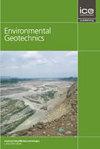Ecological flexible protection method of expansive soil slope under rainfall
IF 2.2
4区 工程技术
Q3 ENGINEERING, GEOLOGICAL
引用次数: 0
Abstract
In this study, a new ecological slope protection method—Anchor Reinforced Vegetation System (ARVS) was applied to the newly excavated expansive soil slope. To explore the effect and mechanism of ARVS protection of newly excavated expansive soil slopes, expansive soil slopes with three different protection methods (bare slopes, grassed slopes, and ARVS slopes) were built. The continuous natural rainfall test and artificial rainfall tests were carried out. The results show that: compared with the bare slope and the grassed slope, ARVS could effectively adjust the moisture and heat balance of newly excavated expansive soil slopes and achieve a satisfactory soil and water conservation performance. Under different rainfall intensities, the runoff and soil loss rates of the ARVS-protected slope were smallest. Under the combined action of vegetation, high-performance turf reinforcement mats (HPTRMs) and anchors, the ARVS provided a superior erosion resistance. The higher the rainfall intensity is, the more significant the anti-erosion effect of the ARVS compared to that of grass protection technology. The ARVS could also effectively limit vertical and horizontal deformation of newly excavated expansive soil slopes. Therefore, the ARVS could effectively reduce the negative influences of the atmospheric environment on newly excavated expansive soil slopes and provide a new solution for shallow protection of newly excavated expansive soil slopes.降雨条件下膨胀土边坡的生态柔性防护方法
本研究对新开挖的膨胀土边坡采用了一种新的生态边坡防护方法--锚固植被系统(ARVS)。为了探索 ARVS 对新开挖膨胀土边坡的防护效果和机制,研究人员建造了三种不同防护方法(裸坡、植草护坡和 ARVS 护坡)的膨胀土边坡。进行了连续自然降雨试验和人工降雨试验。结果表明:与裸坡和植草护坡相比,ARVS 能有效调节新开挖膨胀土边坡的水分和热量平衡,达到令人满意的水土保持性能。在不同降雨强度下,ARVS 防护边坡的径流和土壤流失率最小。在植被、高性能草皮加固垫(HPTRMs)和锚杆的共同作用下,ARVS 具有优异的抗侵蚀能力。降雨强度越高,ARVS 的抗侵蚀效果就比草皮防护技术更显著。ARVS 还能有效限制新开挖的膨胀土边坡的垂直和水平变形。因此,ARVS 可有效减少大气环境对新开挖膨胀土边坡的不利影响,为新开挖膨胀土边坡的浅层防护提供了一种新的解决方案。
本文章由计算机程序翻译,如有差异,请以英文原文为准。
求助全文
约1分钟内获得全文
求助全文
来源期刊

Environmental geotechnics
Environmental Science-Water Science and Technology
CiteScore
6.20
自引率
18.20%
发文量
53
期刊介绍:
In 21st century living, engineers and researchers need to deal with growing problems related to climate change, oil and water storage, handling, storage and disposal of toxic and hazardous wastes, remediation of contaminated sites, sustainable development and energy derived from the ground.
Environmental Geotechnics aims to disseminate knowledge and provides a fresh perspective regarding the basic concepts, theory, techniques and field applicability of innovative testing and analysis methodologies and engineering practices in geoenvironmental engineering.
The journal''s Editor in Chief is a Member of the Committee on Publication Ethics.
All relevant papers are carefully considered, vetted by a distinguished team of international experts and rapidly published. Full research papers, short communications and comprehensive review articles are published under the following broad subject categories:
geochemistry and geohydrology,
soil and rock physics, biological processes in soil, soil-atmosphere interaction,
electrical, electromagnetic and thermal characteristics of porous media,
waste management, utilization of wastes, multiphase science, landslide wasting,
soil and water conservation,
sensor development and applications,
the impact of climatic changes on geoenvironmental, geothermal/ground-source energy, carbon sequestration, oil and gas extraction techniques,
uncertainty, reliability and risk, monitoring and forensic geotechnics.
 求助内容:
求助内容: 应助结果提醒方式:
应助结果提醒方式:


